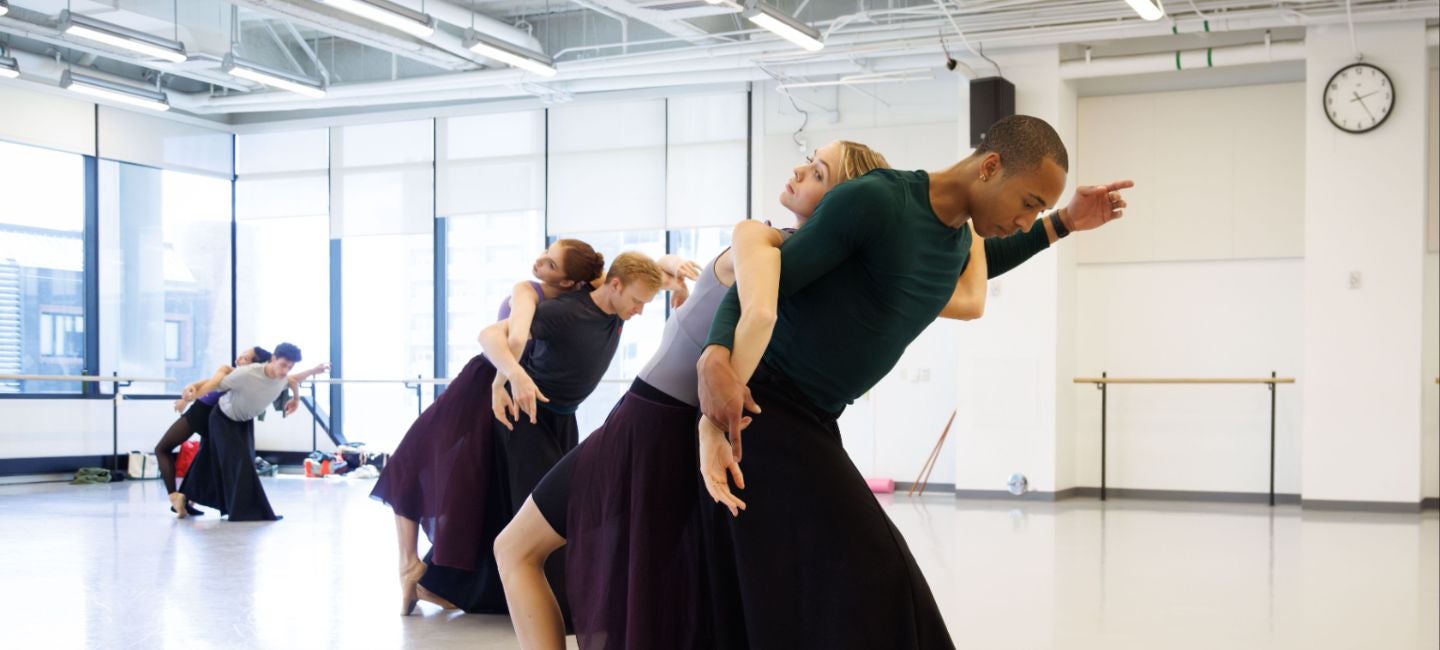
The quiet stillness of a dance studio marks just the beginning of transforming vision into a ballet production. What starts as a concept in a choreographer’s mind soon takes on a life of its own – ideas transform into movement, music supports the concept, costumes and lighting enhance the vision, and ultimately, dancers bring everything to life on a stage filled with movement and wonder.
The magic of creating a ballet became a reality for five company dancers, who were given the opportunity to step beyond performing and create original works for Works from Within, a new program featuring new pieces presented by dancers at Ballet West.
Just how do dancers begin the process? For Principal Artist Katlyn Addison, it began with finding the right story—a Greek mythology that was well known but hadn’t yet been created into a ballet. The story of Andromeda was the perfect fit, so Addison began working with film and television composer Jonathan Sanford to create an original 25-minute score.
“I started with letting him know I would like to create a story about the Greek mythology, Andromeda, then I asked him to just go for it,” Addison explains. From there, she wrote her own shortened version of the mythology from Andromeda’s perspective, breaking it into chapters that corresponded with sections of the music.
For Demi-Soloist Nikki Fannéy, the journey began with uncertainty. “This is my first time choreographing. I wasn’t sure if I was going to even like it,” she reveals. She started by recruiting a fellow dancer as her guinea pig to experiment with movement and music.
Demi-Soloist Vinicius Lima’s approach centers on music to ignite his creative process, drawing inspiration from his Brazilian heritage. “Music is always the muse of my work and that’s how the movements come out,” he explains.
Principal Artist Emily Adams collaborated with film and ballet composer Katy Jarzebowski for her work Mass Hysterical, their fifth creation together. Adams begins by creating the story and characters and then works with the composer to map out the emotional journey they want to create for the audience.
THE POWER OF WORKS FROM WITHIN
Ballet West’s Works from Within was created by Artistic Director Adam Sklute to give company members the opportunity to develop their own original choreographic works. The process began at the end of last season when dancers were invited to submit choreographic ideas.
“The art of choreography is the one art that cannot be fully accomplished alone. I built this program to give our artists access to dancers, time, space, and all manner of production elements,” says Sklute.
This initiative not only showcases the company’s performing talent but also highlights its creative potential within the company’s ranks, giving audiences a chance to experience fresh perspectives in ballet.
FIVE UNIQUE VISIONS
Each choreographer brings a distinct voice and vision to the stage. Adams’ Mass Hysterical explores the comedy and horror of group social behavior. “We first developed the idea in 2022, so it’s kind of a product of that time, emphasizing the importance of being brave when fear seems to be taking over,” said Adams.
Bynum’s With Feeling is deeply personal, about both herself and jazz music, exploring how we connect to music and play around with the different layers that are within jazz music. “I just let the music drive me to create the steps and the creation happened pretty organically, which turned into something really beautiful,” said Bynum.
For Addison, rather than simply retelling the ancient tale, she crafted the story specifically from Andromeda’s perspective, creating a fresh take on classical mythology. “I fell in love with the story because it’s about making a sacrifice for other people and having courage, faith, and trusting in the power of love in chaos,” says Addison.
Fannéy’s Lingering Echoes takes a different approach, deliberately avoiding a specific storyline. Instead, it explores the themes of togetherness and loss, shared memories, and the power of love in the face of separation. “I wanted the dancers to explore their own story while dancing my movement and expressing how we learn and grow from grief,” she explains.
Lima’s work Elis examines four emotional states: love, play, grief, and togetherness. “I’m really fascinated by human feelings,” he says. “I really wanted to translate that to my work with the idea of how it would look through movement. I really want the audience to be able to feel the emotions.”
THE CHOREOGRAPHIC JOURNEY
The path from concept to stage comes with both joys and challenges. For many, the time constraints prove most difficult. Addison acknowledges the challenge of dividing rehearsal
time. “Did I dream too big?” she wondered about creating a 25-minute narrative ballet. Yet she found the Ballet West dancers made the process flow easily, transforming even simple movements into rich storytelling.
Adams highlights the collaborative nature of choreography: “Dance is such a living art form, and choreography requires the input of the dancer as well as the choreographer.” She values the relationship with the dancers, noting how much unfolds in that relationship as they bring their own skills, bodies, and talents to the process.
For Lima, the challenge lies in translating his vision from his mind to twenty different bodies. “Being a choreographer is hard because you don’t have the canvas like a painter has,” he explains. “I do have my body to create on me, but creating on 20 dancers is very different.” He jokes that if the dancers could only see inside his head, “it would make it so much easier.”
Through these five distinct works, Ballet West continues its commitment to nurturing artistic growth from within its ranks, proving that the future of ballet lies not only in preserving tradition but in fostering new creative voices.